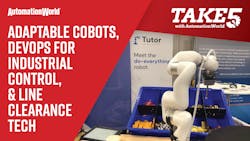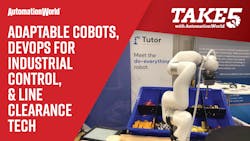At PACK EXPO East: Adaptable Cobots, DevOps for Industrial Control, and Line Clearance Technology
Quick hits:
- MIT startup Tutor Intelligence introduces vision system software that enables cobots to be situationally aware.
- Copia Automation brings Modern DevOps and Git to industrial control.
- Xyntek’s Line Clearance Assistance technology for life sciences automates manual processes using a series of cameras and software.
Welcome to Take Five, I’m Stephanie Neil and since I just got back from PACK EXPO East I wanted to share some of the news I found that will help manufacturing, as well as solve some workforce-related issues.
First, let’s talk about an MIT startup called Tutor Intelligence. They were demonstrating a collaborative robot performing a pick and place application that was grabbing different varieties of wrapped candies.
So the key here is the company’s vision software which allows the cobot to learn complex environments for kitting, feeding, and packing. It does this by using an engine that combines human intelligence and artificial intelligence. This type of human-in-the-loop machine learning allows the engineers to interact directly with the machine and give feedback so that the algorithm learns the environment.
The founders of Tutor say this means there is no custom programming and the system is easy to set up. The bigger benefit, however, is that these robots are available in a pay-by-the-hour leasing plan. This may solve staffing problems by bringing in a cobot to replace a human on the line without a big capital investment. The founders told me that this “drop-in automation” is setting the company up to be more of a robot staffing agency.
So with the theme of making programming easy, we move on to another big story from Copia Automation.
This engineering company is working on bringing modern source code control to industrial automation. The concept of DevOps has been used for 15 years now in IT to deliver applications faster than traditional software development can. And a key part of that is the use of Git, an open source tool that maintains data integrity while coordinating work among programmers developing code in parallel.
Copia CEO Adam Gluck, who founded the company in 2020, says the reason Git has not taken hold in the industrial space yet is because PLC programming languages are visual and don’t work well with Git. Until now that is.
Copia builds ergonomic workflows on top of the tool so that it works with these industrial control languages. And some of Copia’s users are saying this tool is bringing visibility and change management while saving hours of work per engineer each week.
Finally, I wanted to talk about Xyntek, an IT and automation engineering business that serves the life sciences and medical device industries. During PACK EXPO East, Xyntek was demonstrating a system it calls Line Clearance Assistance.
With more specialized medications hitting the market, production lines are used for smaller product runs and are changed more often. Frequent changeovers increase the risk of stray product, contaminants, and incorrect labels entering the manufacturing and packaging lines. That increases the risk of a costly product recall.
This is also a very manual process. Operators need to confirm the line is 100% clear. So Xyntek’s Line Clearance Assistance tool automates this using a series of cameras.
In addition, there is a visual record to prove the line is completely clear and ready to manufacture the next batch, Thompson told me.
You can find more news from PACK EXPO East in the links below and on our website.
That’s it for this edition of Take Five. Thanks for joining me. See you next time.
Leaders relevant to this content:





